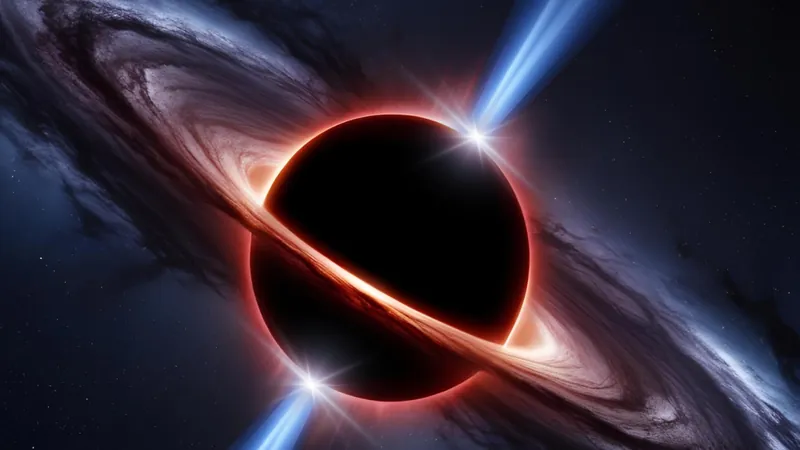
Unlocking the Universe: Can We Tap Into Black Holes as Energy Sources?
2025-04-08
Author: Rajesh
Humankind has long been captivated by the mysteries of black holes, but could we ever transform these cosmic powerhouses into a viable energy source? Recent research invites us to ponder this very question, shining light on some of the universe's most remarkable phenomena.
The Nature of Black Holes
Black holes are enveloped by an event horizon, a boundary shrouded in mystery that prevents us from glimpsing into their enigmatic interiors, where singularities exist. These gravitational giants are unlike any celestial body in our solar system, exhibiting unmatched power that fuels the curiosity of physicists.
Energy Production from Black Holes
When surrounded by matter, black holes can generate some of the most intense energy outputs known, such as quasars—luminous objects millions of times brighter than whole galaxies. This leads scientists to explore whether the immense energy produced by black holes could be harnessed.
Nobel Prize-winning physicist Roger Penrose first speculated in 1969 about an advanced civilization's ability to extract energy from rotating black holes. Jorge Pinochet, a researcher at the Metropolitan University of Educational Sciences, highlights this idea, suggesting that if technology progresses, black holes could offer a clean and efficient energy solution.
The Extraction of Energy
Pinochet and Penrose propose that we could potentially extract kinetic energy from rotating black holes, specifically "Kerr black holes," which spin at velocities near the speed of light—something no other cosmic entity can achieve without being torn apart by centrifugal forces.
As these black holes rotate, they drag the very fabric of space-time around them, a process known as "frame-dragging." This phenomenon means that particles and matter in their vicinity are perpetually in motion, allowing the black hole to impart its rotational kinetic energy to its surroundings.
Nature provides a glimpse into this energy extraction through quasars and microquasars, which occurs when supermassive or stellar black holes pull in surrounding gas and dust. As these materials spiral inward and collide, they transform into hot plasma, releasing immense radiation as they approach the black hole's event horizon.
In some cases, not all material is consumed. Powerful magnetic fields can direct escaping matter into energetic jets—relativistic jets—propelled outward at incredible speeds, showcasing the raw power these black holes command.
Advancing Towards ‘Black Hole Batteries’
While nature has demonstrated energy extraction from black holes, humanity remains far from mimicking this process. A more practical approach might be to harness the radiation emitted by quasars or microquasars, akin to how we exploit solar power on Earth. However, to tap into a black hole's rotational energy would require extraordinary advancements in technology.
Pinochet illustrates this complex extraction concept with a carousel analogy. Imagine a carousel spinning effortlessly: if a child throws a ball against its direction of rotation, the ball rebounds with greater speed, and the carousel slows down slightly. Similarly, if we could send particles towards a black hole, they could return to us with more energy than they initially had.
However, achieving this level of energy extraction may only be feasible for a hyper-advanced society referred to as a Type II or III civilization on the Kardashev scale—an indicator of a civilization's technological capabilities based on energy harnessing. Currently, humanity ranks at about 0.7, highlighting how distant we are from tapping into the cosmic energy black holes provide.
The Distance Barrier
Even if humanity reaches such heights, significant hurdles remain—namely the physical distance to black holes. The closest known black hole is approximately 1,560 light-years away, while the nearest supermassive black hole lies about 26,000 light-years from Earth. This makes the prospect of interstellar travel to access these energy sources seem like the plot of a science fiction story rather than an achievable objective.
Education and Inspiration
Despite the theoretical potential for black hole energy harvesting, the technological means to realize it are far removed from our current capabilities. Pinochet emphasizes the importance of studying such theoretical ideas to foster curiosity and innovation in future scientists.
For Pinochet, exploring the enigmatic realms of black holes serves a dual purpose: not only does it enrich his understanding of the universe, but it also inspires the next generation of physicists. In the pursuit of knowledge, he references Stephen Hawking’s groundbreaking work on black holes, preparing educational materials that simplify complex topics such as Hawking radiation—the notion that black holes can emit radiation and gradually evaporate over vast timescales.
While engineering practical ways to harness the energy of black holes remains tantalizingly out of reach, contemplating this prospect ignites imaginations and fosters the intellectual exploration essential for scientific progress. The questions surrounding black holes and their energy potential remain grounded in both science and science fiction, urging us to dream of the possibilities that lie ahead.

 Brasil (PT)
Brasil (PT)
 Canada (EN)
Canada (EN)
 Chile (ES)
Chile (ES)
 Česko (CS)
Česko (CS)
 대한민국 (KO)
대한민국 (KO)
 España (ES)
España (ES)
 France (FR)
France (FR)
 Hong Kong (EN)
Hong Kong (EN)
 Italia (IT)
Italia (IT)
 日本 (JA)
日本 (JA)
 Magyarország (HU)
Magyarország (HU)
 Norge (NO)
Norge (NO)
 Polska (PL)
Polska (PL)
 Schweiz (DE)
Schweiz (DE)
 Singapore (EN)
Singapore (EN)
 Sverige (SV)
Sverige (SV)
 Suomi (FI)
Suomi (FI)
 Türkiye (TR)
Türkiye (TR)
 الإمارات العربية المتحدة (AR)
الإمارات العربية المتحدة (AR)